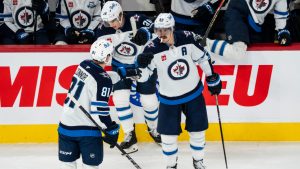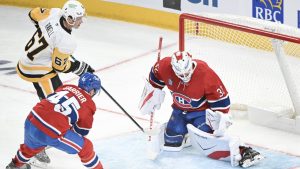They always say that any publicity is good publicity, but NHL officials are likely not thrilled that goalie interference and coach's challenges have already become a major discussion point around the league this season.
Saturday night on Long Island we saw the creation of a new metric in the NHL, which we’ll call the Tkachuk Hat Trick. On one single play Matthew Tkachuk was able to commit goalie interference, an infraction by cross-checking the goalie, and scored a goal amidst the Panthers comeback versus the Islanders.
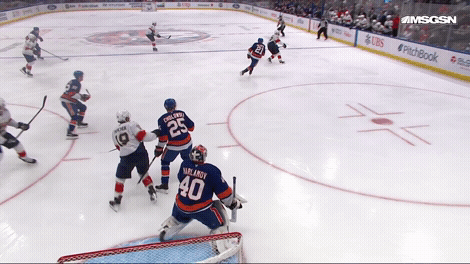
In Edmonton, a slow start was compounded by several goals taken off the board from coach’s challenges, and with multiple “controversial” calls around the league already, hockey fans are once again asking: What is goalie interference?
To answer this question let’s look into the history of goalie interference coach’s challenges, how they get initiated and how the goal posts have moved over the years.
In my past life I spent eight years as an assistant coach and video coach for the Toronto Maple Leafs, Detroit Red Wings and Florida Panthers. During this time, understanding and initiating coach's challenges was a major part of my job. From the constantly changing rules, to the pressure filled situations, challenges have made video coaches one of the most valuable staff members for NHL teams.
So I'll draw from my experience in that seat to help explain what goes into these calls, and decisions.
Going back to the start
Many hockey fans will want to go back to 1999 and talk about the Brett Hull foot in the crease Stanley Cup-winning goal, but let’s start with the introduction of the coach’s challenge that was made in the fall of 2015.
Those challenges started as a reaction to several missed offside calls including an overtime game winner by Nikita Kucherov in the spring of 2015, and the ability to challenge for goalie interference was thrown in as well. I was the one who initiated the first goalie interference challenge and overturned goal in NHL history, which happened during the opening game of the 2015-16 season in Toronto.
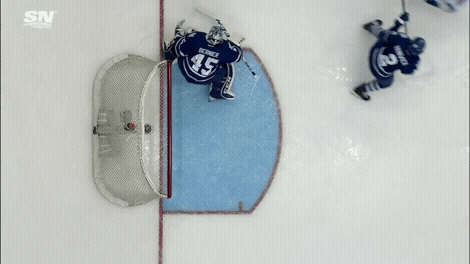
The key difference between offside and goalie interference challenges was the consistency with which they were called. While offside is fairly black and white, successfully challenged roughly 85-90 per cent of the time, it was quickly discovered that goalie interference is much more nuanced and up for interpretation. In today’s NHL, teams are roughly 50-50 in success rate (they were accurate 54 per cent of the time in 2023-24).
Shifting goal posts and adding a penalty
When the coach’s challenge was introduced in the 2015-16 season, the punishment for an unsuccessful challenge was the loss of your timeout. This holds very little value to a coach, so during the first few years you saw varying degrees of approaches to challenging for interference.
In Toronto, since the “cost of a loss” was so low, we would challenge everything we thought was even remotely close. Even if we lost it, we would have a break to refresh and the value of a goal against highly outweighed the value of the timeout. In the first year of the new rule, we led the league with 10 goalie interference challenges.
The league didn’t like all of the stoppages during the game so in 2019 it changed the rule so all failed challenges would result in a minor penalty. This has led to a significant decline in challenge rates, with most coaches only challenging twice and Martin St. Louis as a major outlier at six total challenges for all situations in 2023-24.
Dead Wrong
Each summer at the NHL Draft, Commissioner Gary Bettman would speak to the NHL Coaches' Association. In those early years, video coaches and bench coaches were told that for a challenge to be overturned, it needed to be “Dead Wrong”.
The feeling from the league was that challenges were meant to be something used sparingly and only in situations where there was a glaring mistake. You were not to question the referees and the situation room unless it was a blatant miss.
But there remained an issue that the message from the league was inconsistent with how the rules around goalie interference were being interpreted. This has continued to the present day; the general feeling is there has been inconsistency in how the rules are called.
The Playoff Problem
There has always been a saying that the whistles go away in the playoffs and the standards get tightened up. This holds true for goalie interference challenges, and can be shown in statistics.
During the regular season, coaches in general have a success rate of 45-55 per cent on goalie interference, but during the playoffs that plummets to 22-30 per cent. You can tell this is due to a difference in interpretation, and not in tactics or skill, because the success rate for offside challenges remains the same.
So we know the regular season is different than the playoffs – the numbers back it up. On that note, let’s focus in on the regular season first, and show how there are some commonalities in the plays we have seen debated and discussed on social media so far this season.
What we know: Blue Paint Matters
From rule 69.1:
"Goals should be disallowed only if: (1) an attacking player, either by his positioning or by contact, impairs the goalkeeper’s ability to move freely within his crease or defend his goal..."
Eighty-five per cent of goals in the NHL are scored in the slot/inner slot, which leads to a nightly battle around the net that is going to end up with some questionable plays.
One thing is clear though: if you enter the blue paint on your own, touch the goalie, and the puck goes in the net, there is a good chance the goal will not count.
Oilers fans may not like to hear it, but Corey Perry and Zach Hyman (who make a living in the paint) both entered the blue on these plays, and by the rulebook impaired the goalie’s ability to make a save.
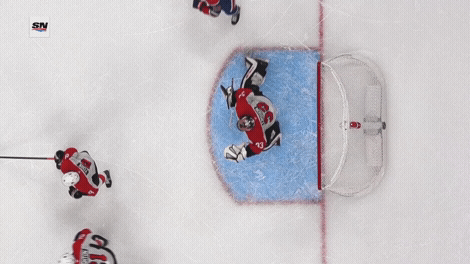
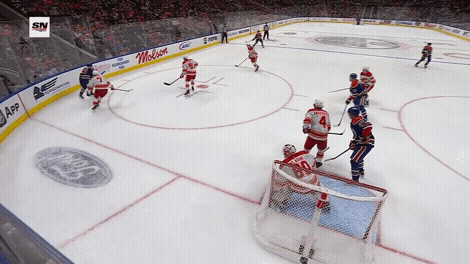
When the offensive team is in the blue paint, it doesn’t matter whether or not there was intent. However, there is some room for grey, due to the use of the word “impair” in the rule book. In this next example, from the recent Ottawa-Los Angeles game, the situation room ruled that while there was contact in the blue paint, it did not impair the goalie’s ability to make the save.
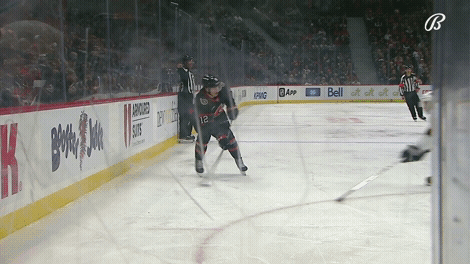
Clear as mud right?
Outside of the Crease
Goalie interference gets even more grey when the play is centred outside of the crease. We continue on Rule 69.1:
“…or (2) an attacking player initiates intentional or deliberate contact with a goalkeeper, inside or outside of his goal crease. Incidental contact with a goalkeeper will be permitted, and resulting goals allowed, when such contact is initiated outside of the goal crease, provided the attacking player has made a reasonable effort to avoid such contact.”
If a player is not in the blue paint, he can still be guilty of goalie interference, but now the contact cannot be “incidental” and instead has to be deliberate. But do we ever really know what a player’s intent is? This is where the biggest grey area arises.
For an example, this goal was overturned because Matt Rempe was inside of the blue paint. There was no “contact” but he impaired the goalie’s ability to defend his net. However, if his skates were three inches further away, it would have been considered a good goal, because there was no deliberate contact. So this is where the blue paint really matters.
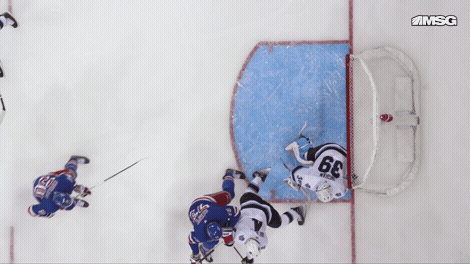
50 Shades of Grey: Pushing the Pad
Now if you really want to make it complicated, let’s look at situations where a player was making a play for a puck that was in the crease. This is actually covered under rule 69.7, Rebounds and Loose Pucks:
"In a rebound situation, or where a goalkeeper and attacking player(s) are simultaneously attempting to play a loose puck, whether inside or outside the crease, incidental contact with the goalkeeper will be permitted, and any goal that is scored as a result thereof will be allowed.
In the event that a goalkeeper has been pushed into the net together with the puck by an attacking player after making a stop, the goal will be disallowed."
This rule means that if there is a loose puck in the crease a player is allowed to “attempt a play” to score a goal.
This interpretation would have been used to determine that Matvei Michkov's first goal would stand, since it appears he is banging at the puck, as it pushes the goalie's pad:
On the flip side, in this example involving Mikey Eissimont, the refs determined that he wasn’t playing the puck and pushed the goalie altogether into the net, therefore calling the goal back.
Clear as mud again, right?
How the standard changes in the playoffs
With all that said, the biggest issue with how coach's challenges on goalie interference are ruled is that the standard changes between the regular season and playoffs. As we discussed, over the past several years coaches have gone from a 50 per cent success rate in the regular season to a 25 per cent success rate in the playoffs when challenging goalie interference.
We've shown and discussed players entering the blue paint in the regular season, and how those goals were called back.
Based on that standard, you'd think this play where Danton Heinen clearly pushes Sergei Bobrovsky's pad inside the blue paint as the puck is coming would result in a goal being overturned, right? Nope. This one ended up counting during the playoffs.
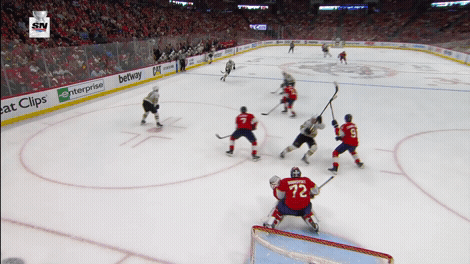
Through these examples we can establish that goalie interference isn’t a black and white decision. There are going to be some grey areas left open to interpretation, but that standard shifts depending on the time of season.
It's easy to point out any problems and much harder to come up with solutions. So I'll pitch a few potential ways to fix the inconsistency we see with how goalie interference is handled on coach's challenges.
Eliminate the coach's challenge for goalie interference
In 2024 you can challenge a goal or penalty for the following situations:
• Offside (Black and White)
• Missed Stoppage for hand pass, puck over glass, or high stick (Black and White)
• Delay of Game for puck over glass (Black and White)
• Goalie Interference (Grey)
Even though most of these other decisions are black and white there are still reasons why you could miss a challenge, whether it be lack of a camera angle to prove the infraction, or a new camera angles that come to light after the challenge has been made.
However, goalie interference is the only one that is in a grey area, so why not just eliminate this all together, and let the call on the ice stand just as it would for most penalties?
Go back to no penalty for failed challenges, especially in the playoffs
If you’re dead set on keeping the challenge, go back to punishing a failed challenge with the loss of a timeout, and only charge a penalty if a team fails a challenge without having a timeout.
The stats show that the standards change in the playoffs, so why not go back to not penalizing the challenging team for making a decision that may have been right in the regular season, but interpreted differently in the playoffs?
Let’s be honest, hockey isn’t the only sport that struggles with rule interpretations. I would challenge you to scroll through social media on any NFL Sunday.
This issue isn’t unique to the sport of hockey or even easy to fix. I think the NHL tries to show consistency in its interpretations, but whether it’s pass interference in the NFL, or goalie interference in the NHL, decisions that are made by humans will always have errors.


